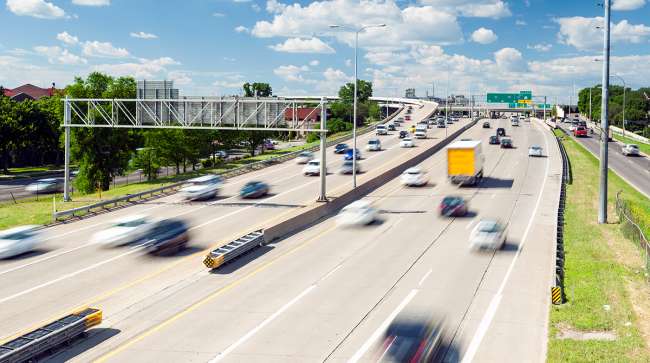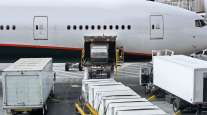Staff Reporter
Truckload Sector Sees Continued Strength in Q4

[Stay on top of transportation news: Get TTNews in your inbox.]
The truckload sector continued to experience a strong pricing environment during the fourth quarter amid marginal fleet growth.
“I’d say that the biggest trend or takeaway from the fourth quarter was it was very much a continuation of what we saw throughout a lot of 2021,” KeyBanc analyst Todd Fowler told Transport Topics. “No real big difference. Just a continuation of what’s been a very strong freight market on the truckload side.”
Fowler added the sector’s strength has been almost at a peak for the past five or six quarters.
“Underlying trends remain really favorable,” said Jack Atkins, transportation research analyst at Stephens. “There are a couple of things I would call out. First, we’re starting to see truckload fleets grow again. Now we’re not talking about year-over-year growth. We’re talking about sequential growth.”
Atkins noted the average fleet count was still down 5.4% versus peak levels in second quarter 2019. But carriers raising rates, improving driver quality of life, expanding driver schools and overall recruiting is beginning to translate into some sequential improvements.
“We did see some stabilization and in some cases progress in terms of building the fleet, which is actually quite counter to what the trend has been for the last couple of years,” Citigroup analyst Christian Wetherbee said. “Now it’s tough to grow these fleets in this environment because you have to pay people a lot and it may not be frankly all that economic to do it. But I do think that the truckers have a greater ability to try at this point.”
Fowler agreed there was some sequential improvement in seated tractor count but it was a very small and incremental change. He noted it primarily occurred in the over-the-road and regular routes segments. He pointed to the improving pandemic environment during the quarter and efforts by truckload carriers to bolster recruitment as the likely driving factors.

Host Michael Freeze discusses cleaner emissions and the GHG Phase 2 rule with Taki Darakos of Pitt Ohio and Dustin Smith at Wabash. Hear a snippet above, and get the full program by going to RoadSigns.TTNews.com.
“I think that the combination of those things all kind of came together,” Fowler said. “Several carriers talked about seeing a continuation of that sequential improvement into 2022. Nothing heroic but it feels like maybe we’re through the worst on the driver availability side.”
“Since the expiration of the enhanced unemployment benefits around Labor Day, we’ve seen an uptick in driver recruiting and driver hiring,” Atkins said.
The CARES Act established a program in response to the coronavirus pandemic that extended unemployment compensation benefits by 13 additional weeks. Another program established by the act provided an additional $600 weekly to unemployment benefits. But the enhanced benefits expired Sept. 6.
“That would be the first thing I would call out,” Atkins said. “The second thing is we’re still seeing significant pressure on utilization in terms of miles per truck. Rates are more than enough to offset that, but utilization of the truck from a miles per-truck, per-week perspective still remains under pressure.”
Cowen and Co. analyst Jason Seidl pointed out that the chances of capacity rebounding is limited given that finding qualified drivers and getting new equipment is still exceptionally difficult. But his research does show seated tractor count has flattened year-over-year for smaller carriers.

Seidl
“These smaller carriers do a better job of seating their fleets than the larger carriers do,” Seidl said. “But that’s not saying that there’s really growth in the overall marketplace. And I think you’re going to have some things coming up in the back half of the year, which is going to provide further challenges to capacity.”
Seidl pointed to the potential impacts from the $1.2 trillion infrastructure bill such as the transportation of building materials and that it could possibly draw some drivers into construction.
“We knew pricing would be strong given how tight the market was,” Bank of America analyst Ken Hoexter said. “They were able to outpace cost inflation with that. So given the scaling of driver pay, one company mentioned it was up 22% year-over-year, and yet on a per-mile basis you were able to see rates at many of the carriers outpace that.”
Hoexter noted that a question that remains is whether the supply side eventually catches up or surpasses demand when everything becomes more stable. With all the efforts to recruit drivers and order equipment it is possible the industry will overshoot capacity needs when demand starts going back down. In that case there would be downward pressure on rates.
“I think we’re still in that tight market that has led us to this stronger-for-longer theme,” Hoexter said. “We haven’t quite found that equilibrium yet, which is why the rates have stayed strong and continue to remain so strong.”
Wetherbee noted that beyond just the topline revenues truckload carriers also saw strong revenue per mile, revenue per hundredweight and average revenue per tractor per week. But at the same time, he noted, there were also some significant inflationary cost pressures.
“We would argue that Werner and Schneider maybe didn’t see as much operating leverage or profit leverage as we had hoped or expected due to some of the elevated costs,” Wetherbee said. “I think a lot of that has to do with driver pay and availability.”
Want more news? Listen to today's daily briefing below or go here for more info:



